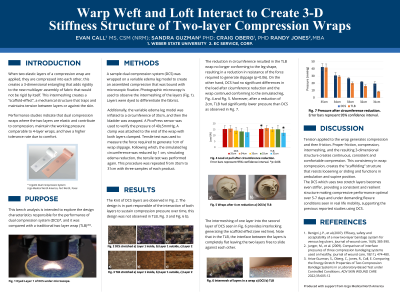Laboratory Research
(LR-004) Warp Weft and Loft Interact to a Create 3-D Stiffness Structure of Two-Layer Compression Wraps
Friday, April 28, 2023
7:15 PM - 8:30 PM East Coast USA Time

Sandra Guzman, PhD – Senior Test Engineer, EC Service, Corp.; Craig Oberg, PhD – Distinguished Professor, Weber State University; Randy Jones, MBA – Board Member, EC Service, Corp.
Introduction: Performance studies indicate that dual compression wraps where the two layers are elastic and contribute to compression maintain the working pressure, over one week, comparable to 4-layer wraps with a higher tolerance rate due to comfort. This bench analysis is intended to explore the design characteristics responsible for this unique performance.
When two elastic bandages are combined, they are contracted to each other, and this create rigidity in a fabric that would not be rigid by itself. This combination causes the fabrics to intermesh creating an “scaffold-effect” and allowing the gain of a mechanical structure that traps and maintain tension between layers or against the skin.
Elastic compression under friction squeezes the warp, weft and loft of the fabric making an interlocking structure that gains 3-D stiffness along and across the bandage. Tension then via the LaPlace law translates to compression making the assembly of fabrics stiff in all three-dimensions.
Methods: A sample of a dual compression system (DCS*) is wrapped in a leg model to create an imbedding assembled compression using polymer isolation. Photographic microscopy is used to measure the intermeshing of the layers. Additionally, three samples of the intermeshed layers of the DCS* are stretched standing vertically to measure the resistance to slippage and sag using a tensile test.
Results: Photographic and measurement results demonstrate the intermingling of fabrics, trapped in compression under LaPlace law translated tension.
Discussion: The principles presented in this study applied in compression wraps is utilized to create the proper friction, compression, intermeshing, and structure that creates a consistent compression, that under this “scaffolding” structure does not lose or slide and works both for the ambulatory as well as supine situations. The principle using two different stretch layers becomes even stronger providing a consistent, resilient strong stiffness making the conditions of compressive performance optimal over 5-7 days and under demanding flexure conditions seen in walking mobility supporting the previous reported studies using DCS*.
When two elastic bandages are combined, they are contracted to each other, and this create rigidity in a fabric that would not be rigid by itself. This combination causes the fabrics to intermesh creating an “scaffold-effect” and allowing the gain of a mechanical structure that traps and maintain tension between layers or against the skin.
Elastic compression under friction squeezes the warp, weft and loft of the fabric making an interlocking structure that gains 3-D stiffness along and across the bandage. Tension then via the LaPlace law translates to compression making the assembly of fabrics stiff in all three-dimensions.
Methods: A sample of a dual compression system (DCS*) is wrapped in a leg model to create an imbedding assembled compression using polymer isolation. Photographic microscopy is used to measure the intermeshing of the layers. Additionally, three samples of the intermeshed layers of the DCS* are stretched standing vertically to measure the resistance to slippage and sag using a tensile test.
Results: Photographic and measurement results demonstrate the intermingling of fabrics, trapped in compression under LaPlace law translated tension.
Discussion: The principles presented in this study applied in compression wraps is utilized to create the proper friction, compression, intermeshing, and structure that creates a consistent compression, that under this “scaffolding” structure does not lose or slide and works both for the ambulatory as well as supine situations. The principle using two different stretch layers becomes even stronger providing a consistent, resilient strong stiffness making the conditions of compressive performance optimal over 5-7 days and under demanding flexure conditions seen in walking mobility supporting the previous reported studies using DCS*.

.png)